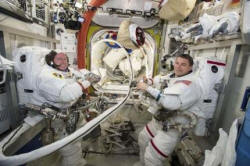|
 Spacewalking
astronauts begin preparing station for new space taxis Spacewalking
astronauts begin preparing station for new space taxis
 Send a link to a friend
Send a link to a friend
[October 16, 2014]
By Irene Klotz
CAPE CANAVERAL Fla (Reuters) - A pair of
spacewalking NASA astronauts hustled through an electrical repair job
outside the International Space Station on Wednesday, then began work to
prepare the outpost for new commercial space taxis.
|
|
 Station flight engineers Reid Wiseman and Barry “Butch” Wilmore
floated outside the station’s airlock shortly after 8:15 a.m. EDT to
begin a 6-1/2-hour spacewalk. Station flight engineers Reid Wiseman and Barry “Butch” Wilmore
floated outside the station’s airlock shortly after 8:15 a.m. EDT to
begin a 6-1/2-hour spacewalk.
Their primary job was to replace a voltage regulator that failed in
May, cutting out one of the station’s eight power channels. The work
needed to be done during a nighttime pass around Earth when the
solar arrays are not generating power. The station, a $100 billion
research complex, flies about 260 miles (420 km) above Earth.
After collecting their tools and making their way to the right-side
exterior truss, the astronauts had just 35 minutes to unbolt the
failed unit and install the replacement. The bolts, however, were
not cooperative.
"The PGT (pistol grip tool) doesn't have enough power to turn it
right now," Wiseman radioed to Mission Control in Houston. "I can
feel it binding up."
 Wiseman then switched to a ratchet wrench to unbolt the failed
device, known as a sequential shunt unit, or SSU.“Now it’s time for
Wiseman to apply a little muscle,” NASA commentator Rob Navias said
during a live broadcast on NASA TV.
That did the trick, clearing the spot for the new SSU. Wiseman again
ran into problems installing the replacement, but as the minutes
ticked down toward daylight, he was able to use the power tool and
then the ratchet wrench to tighten the single bolt holding the SSU
in place.
With less than two minutes before the station passed back into
daylight, flight controllers tested the new unit and reported it was
working properly, "Whoo-hoo," the spacewalkers radioed to Mission
Control.
Wiseman and Wilmore then kicked off what is expected to be a
yearlong NASA project to reconfigure the station for the arrival of
privately owned and operated passenger spaceships. NASA hired Boeing
and privately owned Space Exploration Technologies to begin flying
crews to the station in 2017.
[to top of second column] |

Preparing docking ports and other amenities for the new vehicles
will take up to 10 more spacewalks next year, NASA officials said.
Wiseman and Wilmore began the work by relocating a camera support
mast, clearing a path for the station’s robotic crane to move a
storage module from the Unity to the Tranquility connection nodes
next summer.
Wiseman and Wilmore also moved a wireless transmitter and installed
a new camera.
Wednesday’s spacewalk was the second for Wiseman and the first for
Wilmore.
Two Russian crewmates plan another spacewalk on Oct. 22 to replace
experiments, inspect and photograph the exterior of the Russian side
of the station and take care of some maintenance.
(Reporting by Irene Klotz; Editing by Jonathan Oatis)
[© 2014 Thomson Reuters. All rights
reserved.] Copyright 2014 Reuters. All rights reserved. This material may not be published,
broadcast, rewritten or redistributed.

 |